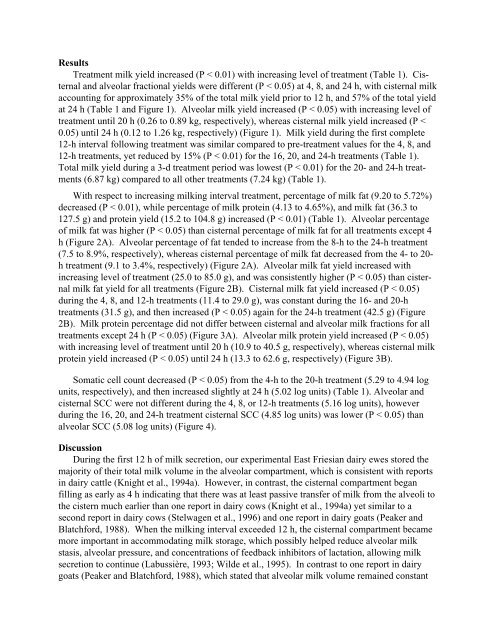Dairy Sheep Symposium - the Department of Animal Sciences ...
Dairy Sheep Symposium - the Department of Animal Sciences ...
Dairy Sheep Symposium - the Department of Animal Sciences ...
Create successful ePaper yourself
Turn your PDF publications into a flip-book with our unique Google optimized e-Paper software.
Results<br />
Treatment milk yield increased (P < 0.01) with increasing level <strong>of</strong> treatment (Table 1). Cisternal<br />
and alveolar fractional yields were different (P < 0.05) at 4, 8, and 24 h, with cisternal milk<br />
accounting for approximately 35% <strong>of</strong> <strong>the</strong> total milk yield prior to 12 h, and 57% <strong>of</strong> <strong>the</strong> total yield<br />
at 24 h (Table 1 and Figure 1). Alveolar milk yield increased (P < 0.05) with increasing level <strong>of</strong><br />
treatment until 20 h (0.26 to 0.89 kg, respectively), whereas cisternal milk yield increased (P <<br />
0.05) until 24 h (0.12 to 1.26 kg, respectively) (Figure 1). Milk yield during <strong>the</strong> first complete<br />
12-h interval following treatment was similar compared to pre-treatment values for <strong>the</strong> 4, 8, and<br />
12-h treatments, yet reduced by 15% (P < 0.01) for <strong>the</strong> 16, 20, and 24-h treatments (Table 1).<br />
Total milk yield during a 3-d treatment period was lowest (P < 0.01) for <strong>the</strong> 20- and 24-h treatments<br />
(6.87 kg) compared to all o<strong>the</strong>r treatments (7.24 kg) (Table 1).<br />
With respect to increasing milking interval treatment, percentage <strong>of</strong> milk fat (9.20 to 5.72%)<br />
decreased (P < 0.01), while percentage <strong>of</strong> milk protein (4.13 to 4.65%), and milk fat (36.3 to<br />
127.5 g) and protein yield (15.2 to 104.8 g) increased (P < 0.01) (Table 1). Alveolar percentage<br />
<strong>of</strong> milk fat was higher (P < 0.05) than cisternal percentage <strong>of</strong> milk fat for all treatments except 4<br />
h (Figure 2A). Alveolar percentage <strong>of</strong> fat tended to increase from <strong>the</strong> 8-h to <strong>the</strong> 24-h treatment<br />
(7.5 to 8.9%, respectively), whereas cisternal percentage <strong>of</strong> milk fat decreased from <strong>the</strong> 4- to 20h<br />
treatment (9.1 to 3.4%, respectively) (Figure 2A). Alveolar milk fat yield increased with<br />
increasing level <strong>of</strong> treatment (25.0 to 85.0 g), and was consistently higher (P < 0.05) than cisternal<br />
milk fat yield for all treatments (Figure 2B). Cisternal milk fat yield increased (P < 0.05)<br />
during <strong>the</strong> 4, 8, and 12-h treatments (11.4 to 29.0 g), was constant during <strong>the</strong> 16- and 20-h<br />
treatments (31.5 g), and <strong>the</strong>n increased (P < 0.05) again for <strong>the</strong> 24-h treatment (42.5 g) (Figure<br />
2B). Milk protein percentage did not differ between cisternal and alveolar milk fractions for all<br />
treatments except 24 h (P < 0.05) (Figure 3A). Alveolar milk protein yield increased (P < 0.05)<br />
with increasing level <strong>of</strong> treatment until 20 h (10.9 to 40.5 g, respectively), whereas cisternal milk<br />
protein yield increased (P < 0.05) until 24 h (13.3 to 62.6 g, respectively) (Figure 3B).<br />
Somatic cell count decreased (P < 0.05) from <strong>the</strong> 4-h to <strong>the</strong> 20-h treatment (5.29 to 4.94 log<br />
units, respectively), and <strong>the</strong>n increased slightly at 24 h (5.02 log units) (Table 1). Alveolar and<br />
cisternal SCC were not different during <strong>the</strong> 4, 8, or 12-h treatments (5.16 log units), however<br />
during <strong>the</strong> 16, 20, and 24-h treatment cisternal SCC (4.85 log units) was lower (P < 0.05) than<br />
alveolar SCC (5.08 log units) (Figure 4).<br />
Discussion<br />
During <strong>the</strong> first 12 h <strong>of</strong> milk secretion, our experimental East Friesian dairy ewes stored <strong>the</strong><br />
majority <strong>of</strong> <strong>the</strong>ir total milk volume in <strong>the</strong> alveolar compartment, which is consistent with reports<br />
in dairy cattle (Knight et al., 1994a). However, in contrast, <strong>the</strong> cisternal compartment began<br />
filling as early as 4 h indicating that <strong>the</strong>re was at least passive transfer <strong>of</strong> milk from <strong>the</strong> alveoli to<br />
<strong>the</strong> cistern much earlier than one report in dairy cows (Knight et al., 1994a) yet similar to a<br />
second report in dairy cows (Stelwagen et al., 1996) and one report in dairy goats (Peaker and<br />
Blatchford, 1988). When <strong>the</strong> milking interval exceeded 12 h, <strong>the</strong> cisternal compartment became<br />
more important in accommodating milk storage, which possibly helped reduce alveolar milk<br />
stasis, alveolar pressure, and concentrations <strong>of</strong> feedback inhibitors <strong>of</strong> lactation, allowing milk<br />
secretion to continue (Labussière, 1993; Wilde et al., 1995). In contrast to one report in dairy<br />
goats (Peaker and Blatchford, 1988), which stated that alveolar milk volume remained constant
















